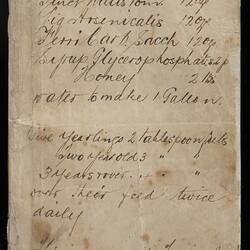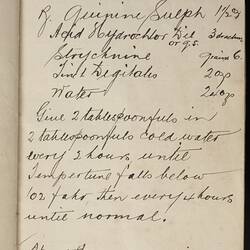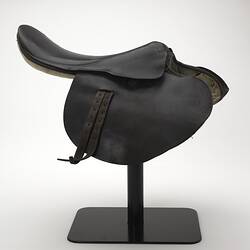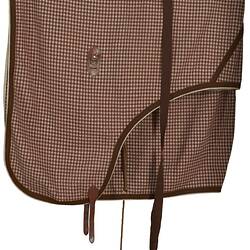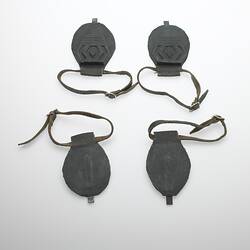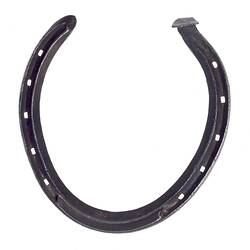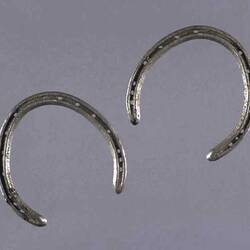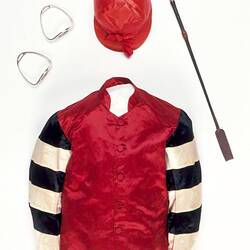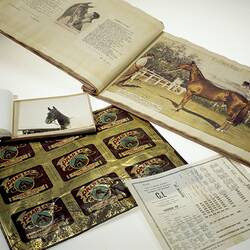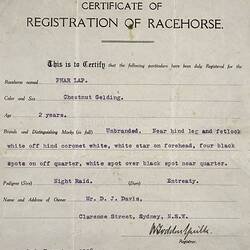Summary
Allternative Name(s): Note Book; Recipe Book
This tonic book belonged to Harry Telford, part owner and trainer of the champion racehorse Phar Lap. It contains 30 handwritten recipes (28 of them in Telford's handwriting) for horse tonics and ointments; homeopathic remedies commonly used for treating ailments or as stimulants in racehorse diets during the 1920s and 1930s.
The tonic book was originally owned by Harry Telford and used by him during the 1930s, and possibly the late 1920s, including the period 1928-1932 during which he was leasee and trainer (and later part owner) of Phar Lap. In April 1930 Telford took over the property Braeside, near Mordialloc on the south-eastern outskirts of Melbourne. He established a horse training facility, stables and stud at the property and moved his business there from Sydney. Braeside become the main base for Phar Lap from April 1930 until his trip to America in early 1932. When Telford gave up the lease on the Braeside property in 1940, he passed the book onto Ernie Fellows.
Ernie Fellows had started out as Harry Telford's trackwork jockey at Braeside in the 1930s, and went on to have a successful career as a horse trainer both in Australia and Europe, including training the winners of the 1954 Victoria Derby, and the 1964 Newmarket 2000 Guineas Stake in England.
In the late 1930s, Tommy Woodcock, Phar Lap's strapper and primary carer, wrote the following of his experiences with dopes and tonics in a series of articles published in the Australian press under the title 'Phar Lap Memories':
'Strange to say several people came to Harry Telford with tonics that they vowed would put yards on to the pace of the great horse. Telford was impressed by such men. He was prepared to try anything that would do Phar Lap good. If the bottles of tonic that were left for the horse were consumed he would have been a walking dispensary.'
'When Telford received a new bottle of tonic accompanied by a story worthy of a Yankee salesman, he would tell me how marvellous it was and give me instructions how it had to be used and in what quantities.'
'At first I useed to argue that the a horse like Phar Lap did not want a tonic, but as time went on I adopted different tactics. To please Telford I would take the bottle, but I would pour a quantity down the drain each day so that he would think that I was carrying out his instructions.'
'Harry often stood off and admired the horse and remarked: "You can see him improving every day on that tonic." I always agreed and laughed up my sleeve at the thought of a champion like Phar Lap wanting anything to improve him. He was a horse and a half, and to try to find a tonic to improve an animal in perfect health was absurd.'
'One of Melbourne's best-known racing men came as regular as clockwork with his bottles of tonic, and just as regularly I poured them down the sink.'
Physical Description
82 page notebook (missing covers) with manuscript recipes for tonics and ointments for racehorses, with 28 recipes in Harry Telford's hand, and another two added by Ernie Fellows. Ingredients include arsenic, strychnine, belladonna, cocaine & caffeine. Notebook with some wear, and first page has been reinserted after page 12. The handwriting in the book compares favourably with handwritten Harry Telford documents held in the archives of Museum Victoria.
Significance
This tonic book belonged to Harry Telford, part owner and trainer of the champion racehorse Phar Lap. It contains 30 handwritten recipes (28 of them in Harry Telford's handwriting) for horse tonics and ointments; homeopathic remedies commonly used in the 1920s and 1930s.
The tonic book provides a fascinating insight in the often clandestine world of racehorse training and care, it is also an important research tool for the Museum's ongoing research into the possible causes of the sudden and mysterious death of Phar Lap in the United States in April, 1932. His trainer at the time, Tommy Woodcock, confessed just before his death that he thought he may have poisoned Phar Lap by incorrectly administering one of the tonics which contained arsenic.
Phar Lap
From the beginning of 1930 until his death, Phar Lap raced in 36 races, winning an amazing 32 of them, with two seconds and a third. The only race in which he was unplaced was the 1931 Melbourne Cup, where he had been given a record weight by the handicappers.
It was this astonishing record that endeared Phar Lap to the Australian public, especially during the increasingly harsh years of the Depression. Phar Lap came to represent the Australian 'battler' - the horse had been an ungainly yearling, and then gradually grown into a champion. While the racing authorities kept increasing his weights in an attempt to bring him back to the field, the public cheered on every Phar Lap victory, even though the betting odds were so short that they could make little money by backing him.
In 1932 Phar Lap was sent to North America to race in their richest race, the Agua Caliente Handicap, with a winner's prize of $50,000. Australians cheered on their national hero, and followed his training schedule and preparations closely. The radio broadcast back in Australia was fairly rough, but people certainly got the right idea: Phar Lap had won. There were tens of thousands of perfectly synchronised scenes of jubilation across the country. Never before had Australia experienced such a sense of live participation in an international sporting event.
Less than three weeks later, the nation was swept into a deep mourning, as news filtered through of Phar Lap's sudden death in California. This was quickly followed by recriminations, as accusations of poisoning by American mobsters filled the papers. Over 75 years later, mystery still surrounds the circumstances of his sudden demise, and the contents of this tonic book may go someway to help solve this.
More Information
-
Collection Names
-
Collecting Areas
-
Acquisition Information
Purchase
-
Acknowledgement
Purchased with the assistance of the National Cultural Heritage Account
-
Creator
Harry Telford, Mordialloc, Greater Melbourne, Victoria, Australia, 1920s-1930s
It has been confirmed that most of the handwritting in the book is in Harry Telford's hand. -
Place & Date Used
-
User
Mr Ernie Fellows, Melbourne, Victoria, Australia, 1940-1960s
Two of the last recipes written in the book are in Ernie Fellows hand. -
Inscriptions
Extensive text handwritten in black ink by Harry Telford & Ernie Fellows.
-
Classification
-
Category
-
Discipline
-
Type of item
-
Object Dimensions
105 mm (Width), 5 mm (Depth), 162 mm (Height)
Measurement From Conservation. Closed book
-
Keywords
Animal Husbandry, Homeopathy, Horse Racing, Horses, Racing Industry, Sport, Veterinary Care, Making History - Phar Lap

